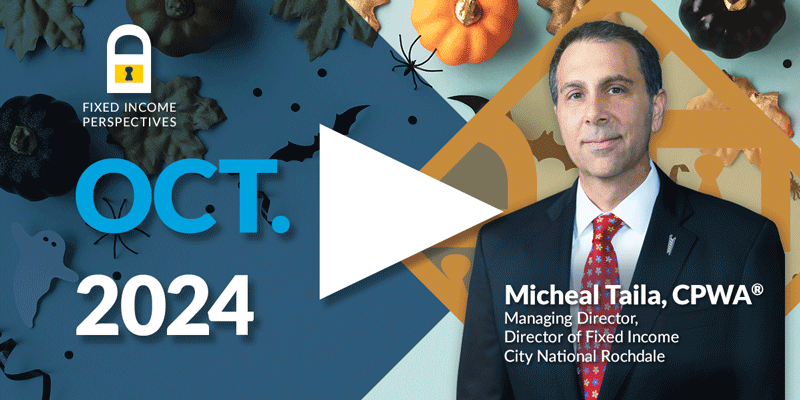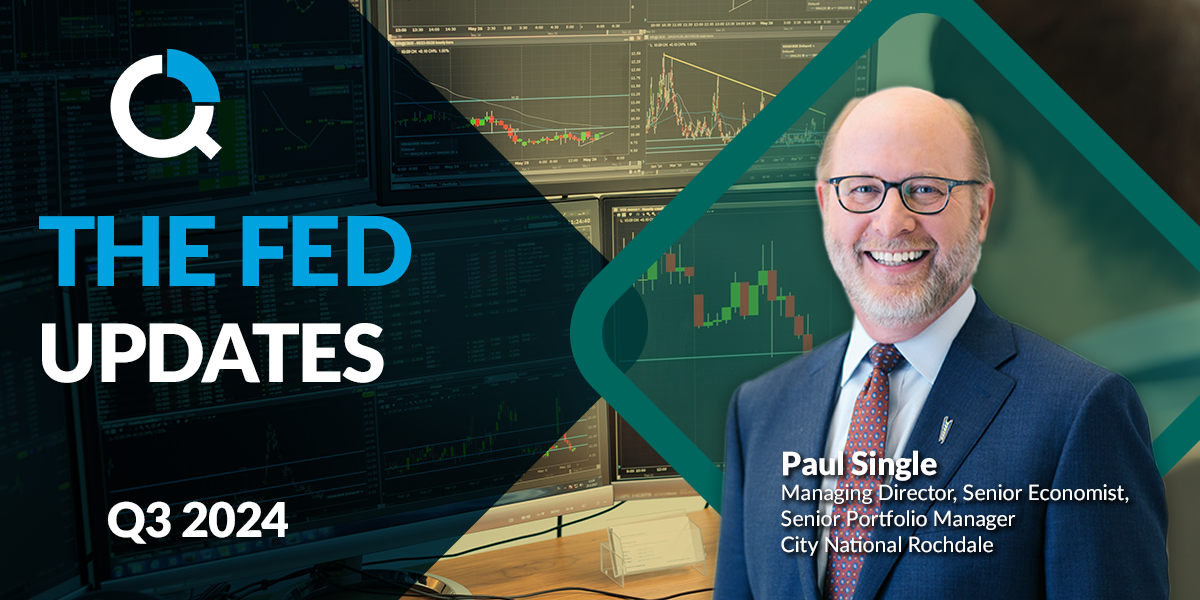

March 21, 2024
What caused the shift in the market belief to a soft landing from a recession?
Surprisingly, the Fed’s 525 basis point (5.25%) increase in the federal funds rate, one of the fastest and most extreme movements since the 1980s, did not cause much of an economic slowdown. It helped bring inflation down from a peak of 9.1% to the current level of 3.2%1, near the Fed’s target rate of 2.0%.
At the same time, the unemployment rate has only increased by 0.1% since the Fed began raising the federal funds rate (see chart). At the same time, the economy has continued to roar along; GDP growth has averaged a solid 2.4%2, and last quarter came in at an even stronger 3.2%2. The most surprising economic data since the Fed began raising interest rates in March 2022 is that the average monthly increase in nonfarm payrolls stands at 280,0003. For some perspective, it averaged about 100,000 less each month in the five years before the pandemic3. Anything above 100,000 new jobs each month is considered strong.
CPI & Unemployment Rate
%, CPI is y-o-y, unemployment rate is the actual monthly rate

Source: Bureau of Labor Statistics as of February 2024.
Information is subject to change and is not a guarantee of future results.
This has many economists jokingly referring to the past couple years as the “immaculate disinflation,” the rare and desirable economic phenomenon in which the Fed raises interest rates and inflation declines to a lower level without causing a recession or a significant increase in unemployment.
When will the Fed begin to cut interest rates?
In December, the Fed stated it plans to lower the federal funds rate by 75 basis points by the end of 2024. It didn’t tell us when the rate cuts will happen, just the year-end rate. At the time, CNR predicted that the Fed would not lower rates until the second half of this year, and would cut rates by 50 to 75 basis points. The federal funds futures market quickly began to believe the Fed would start cutting rates in March, and there may be as many as seven cuts of 25 basis points each, for a total of 175 basis points (see chart).
Number of 25 bp Hikes (+) or cuts (-) at Upcoming FOMC Meetings
implied, based upon federal funds futures market from the present level of 5.375%, as of March 15, 2024

Source: Bloomberg WIRP page, as of March 15, 2024
Information is subject to change and is not a guarantee of future results.
Since then, economic data has come in much stronger than expected, especially with job growth, and the inflation rate has ticked up a bit, which is not what the Fed wants. So the federal funds futures market has walked back much of its aggressive view of monetary policy and now believes there will be just three or four cuts.
The Fed is in no hurry to lower interest rates. It does not need to, despite the market's hope. The economy continues to progress steadily, and the disinflation has stalled; CPI is at about the same level as in June. So we believe the Fed will wait for a few more months in hopes that sticky inflationary pressures subside.
Can U.S. equities continue to outperform?
U.S. stocks have consistently outperformed since the end of the global financial crisis, and that outperformance has only grown more pronounced over the past 12 months, driven by the enthusiasm over mega-cap technology companies and artificial intelligence. However, with the gap between relative U.S. and international stocks price-earnings (P/E) multiples at a two-decade high, many investors are wondering if U.S. stocks have become too expensive.
We think there is a strong case to be made that these premiums are justified. International stocks have often historically traded at a meaningful discount compared to those of the U.S. and the S&P 500 tends to be more heavily weighted in margin-rich tech and growth sectors. Moreover, comparing U.S. stocks to international stocks based only on valuation metrics such as P/E multiples ignores the drivers behind the long-term profit advantages of U.S. markets.
For example, return on equity (ROE), a profitability measure that reflects on how well companies are run, has been significantly higher for U.S. stocks compared to international stocks over the past 20 years. There are many reasons why the ROE advantage of U.S. stocks may continue into the future, including more companies in high margin sectors, stronger pricing power, first-mover advantages, capital-light structures, scalability of production and more frequent dividend increases and share buybacks.
Return on Equity (%)

Source: Factset, as of March 2024
Information is subject to change and is not a guarantee of future results.
A core tenet of our investment philosophy, as laid out in CNR’s proprietary 4Ps framework, has been our approach to global asset allocation, which has consistently recognized the benefits for investors of focusing on U.S. exceptionalism. Indeed, many of the abiding structural strengths of the U.S. economy — fiscal responsiveness, labor flexibility and innovative capacity — go a long way toward explaining how the U.S. has navigated the pandemic and rising geopolitical risk better than nearly all others, and why U.S. companies continue to generate stronger earnings growth.
Looking forward, we believe international equities will experience periods of outperformance; however, we do not think such outperformance is sustainable over the longer term. For CNR to become more constructive on the outlook for international equities, we would likely need to see several important changes, including an end to the war in Ukraine and a reversal of authoritarian trends in China, among other developments.
Is it a good time to invest in municipal bonds?
After a sluggish start to the year, municipal market price support has gained a solid footing. For example, municipal bond mutual fund flows, a common demand gauge for the asset class, have experienced net inflows of approximately $6.8 billion YTD4, with high yield funds reporting ten consecutive weekly gains (as of March 13, 2024)4. Positive flows signal an appetite for municipal bond investment. Despite gross supply significantly outpacing the previous year by more than 20% (as of mid-March), demand has overwhelmed available bonds, driving valuations higher5. The ratio of tax-exempt municipal yields vs. comparable Treasuries across key maturities (e.g., 2, 5, 10, and 30 years) has compressed YTD5. Should sharp moves in the rates market occur, some “cheapening” of relative value indicators could develop, creating a buying opportunity. Absolute yields of investment grade (IG) and high yield (HYM) municipal bonds have fluctuated within a range that still exceeds those levels observed in the market over the past several years. According to Bloomberg, the yield-to-worst (YTW) on the IG and HYM indices were approximately 3.4% and 5.5%, respectively, which translates into a taxable equivalent of 5.7% and 9.3%, respectively5.
Yield-to-Worst of Investment Grade and High Yield Municipal Bonds

Sources: Bloomberg, as of March 2024.
Information is subject to change and is not a guarantee of future results.
The ability of investors to earn tax-efficient income and achieve portfolio diversification was a key factor to staying engaged in the market6. In the near term, March has historically generated positive performance for municipal bonds, posting only two negative monthly returns since 2014.5 As the traditional April tax season approaches, in which tax selling of municipal bonds could weaken prices, any dislocation may open an entry point ahead of the traditionally lower-supply summer season. As broader financial market stakeholders closely analyze economic trends for potential changes in Fed policy, the somewhat muted volatility of municipal bonds YTD could shift and impact the yield curve. With credit fundamentals and associated quality spreads stable, albeit near their 52-week lows, performance potential will likely be heavily influenced by rate movement and curve shape in the coming months.
1 Bureau of Labor Statistics data as of June 2022.
2 Bureau of Economic Analysis data, average of the time specified, 2022:Q3 to 2023: Q4 .
3 Bureau of Labor Statistics data, average gain in payrolls.
4 LSEG Global Fund Flows, Refinitiv data, as of March 13, 2024.
5 Bloomberg data, as of March 2024.
6 Based on Bloomberg correlation statstics, as of March 2024.
* Taxable equivalent yield calculation is based on 37% federal + 3.8% Medicare surcharge.
IMPORTANT INFORMATION
The views expressed represent the opinions of City National Rochdale, LLC (CNR) whichare subject to change and are not intended as a forecast or guarantee of future results.Stated information is provided for informational purposes only, and should not beperceived as personalized investment, financial, legal or tax advice or a recommendation ofany security. It is derived from proprietary and non-proprietary sources which have notbeen independently verified for accuracy or completeness. While CNR believes theinformation to be accurate and reliable, we do not claim or have responsibility for itscompleteness, accuracy, or reliability. Statements of future expectations,estimates,projections, and other forward-looking statements are based on available information andmanagement's view as of the time of these statements. Accordingly, such statements areinherently speculative as they are based on assumptions which may involve known andunknown risks and uncertainties. Actual results, performance or events may differmaterially from those expressed or implied in such statements.
All investing is subject to risk, including the possible loss of the money you invest. As withany investment strategy, there is no guarantee that investment objectives will be met andinvestors may lose money. Diversification does not ensure a profit or protect against a lossin a declining market. Past performance is no guarantee of future performance.
Equity securities. There are inherent risks with equity investing. These risks include, but are not limited to stock market, manager or investment style. Stock markets tend to move in cycles, with periods of rising prices and periods of falling prices.
Fixed Income securities. There are inherent risks with fixed income investing. These risks include, but are not limited to, interest rate, call, credit, market, inflation, government policy, liquidity or junk bond risks. When interest rates rise, bond prices fall. This risk is heightened with investments in longer-duration fixed income securities and during periods when prevailing interest rates are low or negative.
High yield securities. Investments in below-investment-grade debt securities, which are usually called “high yield” or “junk bonds,” are typically in weaker financial health. Such securities can be harder to value and sell, and their prices can be more volatile than more highly rated securities. While these securities generally have higher rates of interest, they also involve greater risk of default than do securities of a higher-quality rating.
The 4P analysis is a proprietary framework for global equity allocation. Country rankings are derived from a subjective metrics system that combines the economic data for such countries with other factors including fiscal policies, demographics, innovative growth and corporate growth. These rankings are subjective and may be derived from data that contain inherent limitations. MSCI Emerging Markets Asia Index is a free float-adjusted market capitalization index that is designed to measure equity market performance in the Asian emerging markets.
City National Rochdale, LLC, is a SEC-registered investment adviser and wholly owned subsidiary of City National Bank. Registration as an investment adviser does not imply any level of skill or expertise. City National Bank and City National Rochdale are subsidiaries of Royal Bank of Canada. City National Bank provides investment management services through its subadvisory relationship with City National Rochdale, LLC. City National Bank and City National Rochdale are subsidiaries of Royal Bank of Canada.
©2024 City National Rochdale
INDEX DEFINITIONS
S&P 500 Index: The S&P 500 Index, or Standard & Poor’s 500 Index, is a market-capitalization-weighted index of 500 leading publicly traded companies in the U.S. It is not an exact list of the top 500 U.S. companies by market cap because there are other criteria that the index includes.
Bloomberg Investment Grade Municipal Index: The Bloomberg Municipal Index measures the performance of the Bloomberg U.S. Municipal bond market, which covers the USD- denominated Long-Term tax-exempt bond market with four main sectors: state and local general obligation bonds, revenue bonds, insured bonds, and pre-refunded bonds.
The Bloomberg Municipal High Yield Bond Index measures the performance of non-investment grade, US dollar-denominated, and non-rated, tax-exempt bonds.
MSCI EAFE Index. The MSCI EAFE (Europe, Australasia, Far East) Index is a free float-adjusted market capitalization weighted index that is designed to measure developed equity market results, excluding the US and Canada.
DEFINITIONS
CPI: A consumer price index (CPI) is a price index; i.e., the price of a weighted average market basket of consumer goods and services purchased by households. Changes in measured CPI track changes in prices over time.
PCE: The PCE represents the prices of goods and services purchased by consumers in the U.S. Since inflation is a measure of the trend in rising prices, PCE is an important metric in determining inflation.
Yield to Worst (YTW): Yield to worst is a measure of the lowest possible yield that can be received on a bond that fully operates within the terms of its contract without defaulting.
Tax-Equivalent Yield (TEY): The tax-equivalent yield is the return that a taxable bond needs to possess for its yield to equal the yield on a comparable tax-exempt municipal bond.
| Non-deposit investment Products are: • not FDIC insured • not Bank guaranteed • may lose value |
Stay Informed.
Get our Insights delivered straight to your inbox.
Put our insights to work for you.
If you have a client with more than $1 million in investable assets and want to find out about the benefits of our intelligently personalized portfolio management, speak with an investment consultant near you today.
If you’re a high-net-worth client who's interested in adding an experienced investment manager to your financial team, learn more about working with us here


